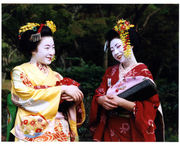[自然]
(1) What is Japan’s climate like?
There are four distinct seasons in Japan; spring, summer, fall and winter. There is also a rainy season between spring and summer. Japan’s climate is influenced by summer and winter monsoons, ocean currents and topographical features.
(1) 日本の気候はどのようなものか。
日本には春夏秋冬というはっきりした四季があり、春と夏の間には雨季もある。
日本の気候は、夏と冬の季節風、海流、地勢に影響を受けている。
(2) How big is Japan?
Japan’s land area is about 378,000 km2, which is slightly smaller than the state of California in the United States or slightly larger than the entire size of Germany. Japan’s archipelago stretches some 3,500 km (2,170 miles) between the northernmost and southernmost points.
(2) 日本の大きさはどれくらいか。
日本の陸域面積は約378,000 km2で、米国のカリフォルニア州よりも少し小さく、
ドイツの全面積よりも少し大きい。日本列島は北端から南端まで約3,500 km (2,170
マイル)伸びている。
(3) Please tell me about the topographical features of Japan.
Japan is a very mountainous island nation. Although its total land area is a little smaller than California, 67% is covered by mountains. Plains account for only 13%. Japan also has 80 of the world’s 800 active volcanoes.
(3) 日本の地形的な特徴について教えてほしい。
日本は非常に山がちな島国である。日本の全陸域面積がカリフォルニアよりも少し
小さいのに、67%が山地である。平野はわずか13%である。また、世界に800個ある
活火山のうち80個が日本にある。
(4) Why are there many volcanoes in Japan?
It is because Japan is located on the circum-Pacific earthquake belt. There are about 80 active volcanoes in Japan. It is said that about 10% of the world’s 800 active volcanoes are concentrated in Japan.
(4) なぜ日本にはたくさんの火山があるのか。
それは日本が環太平洋地震帯の一部に位置しているからだ。日本には約80の活火山
がある。世界にある800の活火山の約10パーセントが日本に集まっていると言われ
ている。
(5) Why are there so many hot springs in Japan?
The number of hot springs has a lot to do with the number of volcanoes. Because Japan has lots of volcanoes, it abounds in natural hot springs.
(5) なぜ日本には非常に多くの温泉があるのか。
温泉の数は火山の数と大いに関係する。日本には多くの火山があるので、日本は温
泉に恵まれている。
(6) Why are there many earthquakes in Japan?
The Japanese archipelago is situated along the North American Plate and the Eurasian Plate. Squeezed in under these plates are the Pacific Plate and the Philippines Sea Plate, which makes the landforms unstable, causing a lot of earthquakes in and around Japan.
(6) なぜ日本は地震が多いのか。
日本列島は北米プレートとユーラシアプレートに沿って位置している。これらのプ
レートの下に押し込まれているのが太平洋プレートとフィリピン海プレートである。
そのことが地形を不安定にし、多くの地震が日本や日本近辺に発生するのである。
● ●
(@@)
>●< 「What should I do when an earthquake occurs?」
(7) What are typhoons?
Typhoons, or Taifu, are violent tropical storms which often strike Japan from early summer through autumn.
(7) 台風とは何か。
台風は、初夏から秋に日本をしばしば襲う激しい熱帯性暴風雨である。
(8) What is tsuyu?
Tsuyu is the early summer rainy season which begins about the middle of June and lasts about a month. This rain is needed by the farmers at rice-planting time.
(8) 梅雨とは何か。
梅雨は、6月中頃に始まり約1ヶ月続く初夏の雨季である。梅雨は田植期の農家に
とって欠かせないものである。
(9) What is the charm of spring in Japan?
In early May, trees are covered in fresh green. Above all, spring is the season when cherry blossoms bloom so beautifully, and people enjoy “hanami,” or Cherry-Blossom-Viewing picnics, under the trees. Also, since it is neither too hot nor too cold, spring is one of the best seasons to travel.
(9) 日本の春の魅力は何か。
5月初旬木々は新しい緑に包まれる。とりわけ春は桜が非常に美しく開花し、人々
は木の下で花見を楽しむ季節である。また、暑すぎず寒すぎないので、春は旅行を
するには最もよい季節のひとつである。
(10) What is the charm of summer in Japan?
If you are interested in outdoor activities, you can enjoy swimming in the sea or climbing mountains. You can also enjoy viewing fireworks displays and Bon dances, throughout Japan in summer.
(10) 日本の夏の魅力は何か。
野外活動に興味があるのなら、海水浴や登山を楽しむことができる。また夏は日本
各地で花火大会や盆踊りを楽しむことができる。
(11) What is the charm of autumn in Japan?
Because it is neither too hot nor too cold, it is one of the best seasons to travel. Besides, a lot of delicious food including seafood and vegetables in season is available in autumn. Also, you can enjoy viewing the beautifully changing colors of autumnal leaves in the mountain.
(11) 日本の秋の魅力は何か。
暑すぎず寒すぎないので、秋は旅行するには最もよい季節のひとつである。それに、
魚介類や野菜を含むたくさんの旬のおいしい食べ物が秋に出回る。また、美しく色
づき始めている山の紅葉を楽しむことができる。
(12) What is the charm of winter in Japan?
You can enjoy skiing and snowboarding in ski resorts such as Niseko in Hokkaido. Its powdery snow is regarded as the best in Japan. Also, I can recommend that you go to Zaozan, on the border of Miyagi and Yamagata Prefectures. This place is famous for its winter landscape of ice-covered trees.
(12) 日本の冬の魅力は何か。
北海道ニセコのようなスキーリゾートでスキーやスノーボーディングを楽しむこと
ができる。ニセコの粉雪は日本で最高のものと見なされている。さらに、宮城県と
山形県の境にある蔵王へ行くことを勧める。蔵王は雪をかぶった木々の冬の景観で
有名である。
[歴史]
(13) Who do you think is the most important person in Japanese history?
I think it’s Tokugawa Ieyasu, who lived from 1543 to 1616. He was the founder and first shogun of the Tokugawa Shogunate, which was to maintain effective rule over Japan from 1600 through 1867. With his sweeping victory in the Battle of Sekigahara in 1600, Ieyasu became the most powerful warrior leader in Japan, and in 1603 he assumed the title of the shogun, thus succeeding in the reunification of Japan. Ieyasu established the “bakuhan” (literally, shogunate-domain) system, which was the political, economic, and social foundation of the entire Edo period.
(13) 日本の歴史の中で最も重要な人は誰だと思うか。
それは徳川家康だと思う。彼は1543年から1616年まで生きた人だ。彼は徳川幕府
を創設しその初代将軍だった。幕府は1600年から1867年まで日本を効果的に支配
することを続けることになった。1600年の関ヶ原の戦いで大勝した家康は日本で最
も力のある戦国大名となった。そして1603年に将軍に就任し、よって日本を再び統
一することに成功した。家康は幕藩体制を作った。それは江戸時代全体の政治的、
経済的、社会的基盤であった。
(14) What do you think is the most important historical event in Japan?
It was the Meiji Restoration. It is narrowly defined to refer to the 1867 coup d’état that overthrew the Tokugawa shogunate, but it more broadly marked the beginning of Japan’s modernization. Following the opening of the country to the West in the mid-19th century, Japan had an influx of various foreign things from Western technology to the military draft system to democracy. Japan abolished its feudalistic shogunate system and developed into a constitutional monarchy.
(14) 日本で最も重要な歴史的な出来事は何だと思うか。
それは明治維新だ。明治維新は狭義には徳川幕府を倒した1867年のクーデターであ
る。しかしもっと広義には日本の近代化の始まりを記したものである。19世紀半ば
に西洋に門戸を開放してから、日本には、西洋の科学技術から徴兵制、民主主義に
いたるまで外国の様々なものがたくさん入ってきた。日本は封建的な幕府を廃して、
立憲君主国に発展していったのである。
(15) Who do you think is the most influential foreigner in Japanese history?
I think it is Commodore Matthew C. Perry, who used “gunboat diplomacy” to make Japan accept and sign “the Treaty of Peace and Amity” (or “Treaty of Kanagawa”) in 1854. This led to the opening of two ports (Shimoda and Hakodate) to American whaling ships. This also meant the end of Japan’s 220-year “sakoku” (seclusion) policy and later Japan’s signing of “The Treaty of Amity and Commerce” under conditions favorable to the U.S. in 1858. These historical events marked the burgeoning Western influence on Japan.
(15) 日本の歴史の中で最も影響力のあった外国人は誰だと思うか。
マシュー・C・ペリー提督だと思う。彼は「砲艦外交」を利用して、1854年に日本
に「和親条約」(神奈川条約)を受け入れさせ、締結させた。このことによって2つ
の港(下田と箱館)がアメリカの捕鯨船に開港したのである。このことはまた、日
本の220年間にわたる鎖国政策が終わったことと、のち1858年に最恵国待遇の条件
で日本がアメリカと「修好通商条約」を締結することを意味した。これらの歴史的
な出来事は、西洋の日本におけるますます大きくなっていく影響をしるしたのであ
る。
(16) Please explain the Meiji Restoration. Why was it so important in Japanese history?
Japan realized the need to establish a modern state to cope with powerful Western countries, once it opened its doors to the world in 1854 after 220 years of national isolation. As a result of strong demands from imperial loyalists of the lower samurai class, the last shogun Tokugawa Yoshinobu stepped down in 1867, and Emperor Meiji came to the throne. Thus, the Meiji Restoration took place in 1868, which included a series of drastic political, economic and cultural changes. Seeking to “enrich the nation and strengthen the military,” the new government promoted industrialization and modernization, through abolishing the feudal system and introducing Western culture and political systems.
(16) 明治維新を説明せよ。日本の歴史の中で明治維新はなぜそれほどまでに重要なの
か。
1854年に日本が220年間の鎖国のあとでいったん開国すると、日本は強い西洋諸国
に対応するため近代国家を作る必要を悟った。武士階級の下層の勤王派からの強い
要求の結果、最後の将軍となった徳川慶喜は1867年に将軍職を退き、明治天皇が即
位した。このようにして明治維新は1868年に起こった。明治維新には一連の抜本的
な政治的、経済的、また文化的改革が含まれる。「富国強兵」を目指して新政府は、
封建制度を廃止し、西洋文化や西洋の政治制度を導入することによって、産業化と
近代化を促進したのである。
(17) When did Japan end its policy of national isolation? How did it happen and what changes it brought to Japan?
In 1853, Commodore Perry and his squadron of American ships appeared in Uraga Bay in Kanagawa to press for the opening of the country. At first, powerful Satsuma (now Kagoshima Prefecture) and Choshu (now Yamaguchi Prefecture) domains were opposed to the idea of giving up the national isolation policy. With their growing knowledge of the Western power, however, they decided to switch their allegiance toward the drive to open up the country. On the other hand, the masses were suffering under inflation, and riots and attacks on shops of wealthy merchants occurred in various regions, weakening the foundations of the bakuhan system. This led in 1867 to the relinquishing of power by the 15th Tokugawa shogun, Yoshinobu, to the imperial court. A decree was made which established a government centered around the emperor, bringing to an end the long-lasting feudal system, and the Meiji period came into being.
(17) 日本はいつその鎖国政策を終わらせたのか。それはどのようにして起こったのか。
またそれは日本にどんな変革をもたらしたか。
1853年にペリー提督とそのアメリカ艦隊は神奈川の浦賀湾に現れ、日本の開国を強
く要求した。初めは勢力のある薩摩藩(現在の鹿児島県)と長州藩(現在の山口県)
は鎖国政策をやめる考えに反対した。しかしながら、西洋列強をだんだんと知るよ
うになると、2藩は支持を切り替えて、日本を開国する運動を支持するようになっ
た。その一方、大衆は物価騰貴のもとで苦しみ、一揆や富裕な商人の店を襲うこと
が様々な地方で起き、幕藩体制の基盤が弱体化することになった。このことによっ
て、15代将軍慶喜は権力を朝廷に譲った。天皇を中心とする政府を樹立する命令が
下り、長い封建制度が終わって、明治時代が始まった。
(18) What was the Edo period like?
The Edo Period is the 260-year span following Tokugawa Ieyasu’s defeat of his principal rivals in the Battle of Sekigahara in 1600 and the establishment of a shogunate government in Edo (now Tokyo) in 1603. This period saw the reinforcement of a status system known as “shi-no-ko-sho” (warrior-peasant-artisan-merchant), which placed the warrior in the top social class, and externally, the establishment of a policy of national isolation and the prohibition of Christianity.
(18) 江戸時代はどんな時代だったのか。
江戸時代とは、1600年の関ヶ原の戦いで徳川家康が主たるライバルを滅ぼし、1603
年、江戸(現在の東京)に幕府を開いてからの260年にわたる期間のことである。
この時代には、武士を一番上の社会階級とする「士農工商」として知られる身分制
度を設け、対外的には、鎖国政策を講じ、キリスト教を禁止した。
(19) What was the Meiji period like?
This period saw the transfer of power from the Tokugawa shogunate to the imperial court, and the transition from a system of government based on the shogunate and “han” domains to a unified state. This was also the period that witnessed the transition to a capitalist economy and the establishment of a modern Japanese state system.
(19) 明治時代はどんな時代だったのか。
この時代は、徳川幕府から朝廷へと政権が移行し、幕府と藩に基づく政治制度から
統一国家へと移り変わった時代である。また、この時代は、資本主義経済へと移行
して、近代日本の制度が確立した時代でもあった。
(20) What is the difference between emperor and shogun?
Shogun was at the top of samurai warriors. The title, shogun, was given by the emperor. The term shogun came to be commonly used with the establishment of the government called bakufu, which controlled the land and people of the nation for about 700 years until the middle of the 19th century. The emperor of Japan is believed to have direct lineage from the Sun Goddess of Japanese mythology. Japanese people refer to the current emperor as Ten-no, and almost never use his actual name. Ten-no doesn’t have any political power whatsoever.
(20) 天皇と将軍の違いは何か。
武士の一番上にいるのが将軍である。将軍という称号は天皇によって与えられた。
将軍ということばは、幕府と呼ばれる政府が創設されるとともに一般に使われるよ
うになった。幕府は国と人民を19世紀の半ばまで約700年にわたって支配した。日
本の天皇は日本の神話の太陽神の直系であると信じられている。日本人は今の天皇
を天皇と言い、天皇の実際の名を使うことはほとんど全くない。天皇は政治権力は
全く持たない。
(21) What is sakoku?
Sakoku was Japan’s policy of isolation from the 17th to the mid-19th centuries. Adopted by the Edo government for security from European countries, the policy also ensured control over regional lords by depriving them of their ability to conduct foreign trade.
(21) 鎖国とは何か。
鎖国は17世紀から19世紀半ばまでの日本の鎖国政策であった。ヨーロッパ諸国か
ら安全に国を守るため、江戸幕府によって採用され、鎖国政策はまた地方の大名が
外国貿易を行うことをできないようにすることによって、彼らに対する支配権を確
実なものにしたのである。
(1) What is Japan’s climate like?
There are four distinct seasons in Japan; spring, summer, fall and winter. There is also a rainy season between spring and summer. Japan’s climate is influenced by summer and winter monsoons, ocean currents and topographical features.
(1) 日本の気候はどのようなものか。
日本には春夏秋冬というはっきりした四季があり、春と夏の間には雨季もある。
日本の気候は、夏と冬の季節風、海流、地勢に影響を受けている。
(2) How big is Japan?
Japan’s land area is about 378,000 km2, which is slightly smaller than the state of California in the United States or slightly larger than the entire size of Germany. Japan’s archipelago stretches some 3,500 km (2,170 miles) between the northernmost and southernmost points.
(2) 日本の大きさはどれくらいか。
日本の陸域面積は約378,000 km2で、米国のカリフォルニア州よりも少し小さく、
ドイツの全面積よりも少し大きい。日本列島は北端から南端まで約3,500 km (2,170
マイル)伸びている。
(3) Please tell me about the topographical features of Japan.
Japan is a very mountainous island nation. Although its total land area is a little smaller than California, 67% is covered by mountains. Plains account for only 13%. Japan also has 80 of the world’s 800 active volcanoes.
(3) 日本の地形的な特徴について教えてほしい。
日本は非常に山がちな島国である。日本の全陸域面積がカリフォルニアよりも少し
小さいのに、67%が山地である。平野はわずか13%である。また、世界に800個ある
活火山のうち80個が日本にある。
(4) Why are there many volcanoes in Japan?
It is because Japan is located on the circum-Pacific earthquake belt. There are about 80 active volcanoes in Japan. It is said that about 10% of the world’s 800 active volcanoes are concentrated in Japan.
(4) なぜ日本にはたくさんの火山があるのか。
それは日本が環太平洋地震帯の一部に位置しているからだ。日本には約80の活火山
がある。世界にある800の活火山の約10パーセントが日本に集まっていると言われ
ている。
(5) Why are there so many hot springs in Japan?
The number of hot springs has a lot to do with the number of volcanoes. Because Japan has lots of volcanoes, it abounds in natural hot springs.
(5) なぜ日本には非常に多くの温泉があるのか。
温泉の数は火山の数と大いに関係する。日本には多くの火山があるので、日本は温
泉に恵まれている。
(6) Why are there many earthquakes in Japan?
The Japanese archipelago is situated along the North American Plate and the Eurasian Plate. Squeezed in under these plates are the Pacific Plate and the Philippines Sea Plate, which makes the landforms unstable, causing a lot of earthquakes in and around Japan.
(6) なぜ日本は地震が多いのか。
日本列島は北米プレートとユーラシアプレートに沿って位置している。これらのプ
レートの下に押し込まれているのが太平洋プレートとフィリピン海プレートである。
そのことが地形を不安定にし、多くの地震が日本や日本近辺に発生するのである。
● ●
(@@)
>●< 「What should I do when an earthquake occurs?」
(7) What are typhoons?
Typhoons, or Taifu, are violent tropical storms which often strike Japan from early summer through autumn.
(7) 台風とは何か。
台風は、初夏から秋に日本をしばしば襲う激しい熱帯性暴風雨である。
(8) What is tsuyu?
Tsuyu is the early summer rainy season which begins about the middle of June and lasts about a month. This rain is needed by the farmers at rice-planting time.
(8) 梅雨とは何か。
梅雨は、6月中頃に始まり約1ヶ月続く初夏の雨季である。梅雨は田植期の農家に
とって欠かせないものである。
(9) What is the charm of spring in Japan?
In early May, trees are covered in fresh green. Above all, spring is the season when cherry blossoms bloom so beautifully, and people enjoy “hanami,” or Cherry-Blossom-Viewing picnics, under the trees. Also, since it is neither too hot nor too cold, spring is one of the best seasons to travel.
(9) 日本の春の魅力は何か。
5月初旬木々は新しい緑に包まれる。とりわけ春は桜が非常に美しく開花し、人々
は木の下で花見を楽しむ季節である。また、暑すぎず寒すぎないので、春は旅行を
するには最もよい季節のひとつである。
(10) What is the charm of summer in Japan?
If you are interested in outdoor activities, you can enjoy swimming in the sea or climbing mountains. You can also enjoy viewing fireworks displays and Bon dances, throughout Japan in summer.
(10) 日本の夏の魅力は何か。
野外活動に興味があるのなら、海水浴や登山を楽しむことができる。また夏は日本
各地で花火大会や盆踊りを楽しむことができる。
(11) What is the charm of autumn in Japan?
Because it is neither too hot nor too cold, it is one of the best seasons to travel. Besides, a lot of delicious food including seafood and vegetables in season is available in autumn. Also, you can enjoy viewing the beautifully changing colors of autumnal leaves in the mountain.
(11) 日本の秋の魅力は何か。
暑すぎず寒すぎないので、秋は旅行するには最もよい季節のひとつである。それに、
魚介類や野菜を含むたくさんの旬のおいしい食べ物が秋に出回る。また、美しく色
づき始めている山の紅葉を楽しむことができる。
(12) What is the charm of winter in Japan?
You can enjoy skiing and snowboarding in ski resorts such as Niseko in Hokkaido. Its powdery snow is regarded as the best in Japan. Also, I can recommend that you go to Zaozan, on the border of Miyagi and Yamagata Prefectures. This place is famous for its winter landscape of ice-covered trees.
(12) 日本の冬の魅力は何か。
北海道ニセコのようなスキーリゾートでスキーやスノーボーディングを楽しむこと
ができる。ニセコの粉雪は日本で最高のものと見なされている。さらに、宮城県と
山形県の境にある蔵王へ行くことを勧める。蔵王は雪をかぶった木々の冬の景観で
有名である。
[歴史]
(13) Who do you think is the most important person in Japanese history?
I think it’s Tokugawa Ieyasu, who lived from 1543 to 1616. He was the founder and first shogun of the Tokugawa Shogunate, which was to maintain effective rule over Japan from 1600 through 1867. With his sweeping victory in the Battle of Sekigahara in 1600, Ieyasu became the most powerful warrior leader in Japan, and in 1603 he assumed the title of the shogun, thus succeeding in the reunification of Japan. Ieyasu established the “bakuhan” (literally, shogunate-domain) system, which was the political, economic, and social foundation of the entire Edo period.
(13) 日本の歴史の中で最も重要な人は誰だと思うか。
それは徳川家康だと思う。彼は1543年から1616年まで生きた人だ。彼は徳川幕府
を創設しその初代将軍だった。幕府は1600年から1867年まで日本を効果的に支配
することを続けることになった。1600年の関ヶ原の戦いで大勝した家康は日本で最
も力のある戦国大名となった。そして1603年に将軍に就任し、よって日本を再び統
一することに成功した。家康は幕藩体制を作った。それは江戸時代全体の政治的、
経済的、社会的基盤であった。
(14) What do you think is the most important historical event in Japan?
It was the Meiji Restoration. It is narrowly defined to refer to the 1867 coup d’état that overthrew the Tokugawa shogunate, but it more broadly marked the beginning of Japan’s modernization. Following the opening of the country to the West in the mid-19th century, Japan had an influx of various foreign things from Western technology to the military draft system to democracy. Japan abolished its feudalistic shogunate system and developed into a constitutional monarchy.
(14) 日本で最も重要な歴史的な出来事は何だと思うか。
それは明治維新だ。明治維新は狭義には徳川幕府を倒した1867年のクーデターであ
る。しかしもっと広義には日本の近代化の始まりを記したものである。19世紀半ば
に西洋に門戸を開放してから、日本には、西洋の科学技術から徴兵制、民主主義に
いたるまで外国の様々なものがたくさん入ってきた。日本は封建的な幕府を廃して、
立憲君主国に発展していったのである。
(15) Who do you think is the most influential foreigner in Japanese history?
I think it is Commodore Matthew C. Perry, who used “gunboat diplomacy” to make Japan accept and sign “the Treaty of Peace and Amity” (or “Treaty of Kanagawa”) in 1854. This led to the opening of two ports (Shimoda and Hakodate) to American whaling ships. This also meant the end of Japan’s 220-year “sakoku” (seclusion) policy and later Japan’s signing of “The Treaty of Amity and Commerce” under conditions favorable to the U.S. in 1858. These historical events marked the burgeoning Western influence on Japan.
(15) 日本の歴史の中で最も影響力のあった外国人は誰だと思うか。
マシュー・C・ペリー提督だと思う。彼は「砲艦外交」を利用して、1854年に日本
に「和親条約」(神奈川条約)を受け入れさせ、締結させた。このことによって2つ
の港(下田と箱館)がアメリカの捕鯨船に開港したのである。このことはまた、日
本の220年間にわたる鎖国政策が終わったことと、のち1858年に最恵国待遇の条件
で日本がアメリカと「修好通商条約」を締結することを意味した。これらの歴史的
な出来事は、西洋の日本におけるますます大きくなっていく影響をしるしたのであ
る。
(16) Please explain the Meiji Restoration. Why was it so important in Japanese history?
Japan realized the need to establish a modern state to cope with powerful Western countries, once it opened its doors to the world in 1854 after 220 years of national isolation. As a result of strong demands from imperial loyalists of the lower samurai class, the last shogun Tokugawa Yoshinobu stepped down in 1867, and Emperor Meiji came to the throne. Thus, the Meiji Restoration took place in 1868, which included a series of drastic political, economic and cultural changes. Seeking to “enrich the nation and strengthen the military,” the new government promoted industrialization and modernization, through abolishing the feudal system and introducing Western culture and political systems.
(16) 明治維新を説明せよ。日本の歴史の中で明治維新はなぜそれほどまでに重要なの
か。
1854年に日本が220年間の鎖国のあとでいったん開国すると、日本は強い西洋諸国
に対応するため近代国家を作る必要を悟った。武士階級の下層の勤王派からの強い
要求の結果、最後の将軍となった徳川慶喜は1867年に将軍職を退き、明治天皇が即
位した。このようにして明治維新は1868年に起こった。明治維新には一連の抜本的
な政治的、経済的、また文化的改革が含まれる。「富国強兵」を目指して新政府は、
封建制度を廃止し、西洋文化や西洋の政治制度を導入することによって、産業化と
近代化を促進したのである。
(17) When did Japan end its policy of national isolation? How did it happen and what changes it brought to Japan?
In 1853, Commodore Perry and his squadron of American ships appeared in Uraga Bay in Kanagawa to press for the opening of the country. At first, powerful Satsuma (now Kagoshima Prefecture) and Choshu (now Yamaguchi Prefecture) domains were opposed to the idea of giving up the national isolation policy. With their growing knowledge of the Western power, however, they decided to switch their allegiance toward the drive to open up the country. On the other hand, the masses were suffering under inflation, and riots and attacks on shops of wealthy merchants occurred in various regions, weakening the foundations of the bakuhan system. This led in 1867 to the relinquishing of power by the 15th Tokugawa shogun, Yoshinobu, to the imperial court. A decree was made which established a government centered around the emperor, bringing to an end the long-lasting feudal system, and the Meiji period came into being.
(17) 日本はいつその鎖国政策を終わらせたのか。それはどのようにして起こったのか。
またそれは日本にどんな変革をもたらしたか。
1853年にペリー提督とそのアメリカ艦隊は神奈川の浦賀湾に現れ、日本の開国を強
く要求した。初めは勢力のある薩摩藩(現在の鹿児島県)と長州藩(現在の山口県)
は鎖国政策をやめる考えに反対した。しかしながら、西洋列強をだんだんと知るよ
うになると、2藩は支持を切り替えて、日本を開国する運動を支持するようになっ
た。その一方、大衆は物価騰貴のもとで苦しみ、一揆や富裕な商人の店を襲うこと
が様々な地方で起き、幕藩体制の基盤が弱体化することになった。このことによっ
て、15代将軍慶喜は権力を朝廷に譲った。天皇を中心とする政府を樹立する命令が
下り、長い封建制度が終わって、明治時代が始まった。
(18) What was the Edo period like?
The Edo Period is the 260-year span following Tokugawa Ieyasu’s defeat of his principal rivals in the Battle of Sekigahara in 1600 and the establishment of a shogunate government in Edo (now Tokyo) in 1603. This period saw the reinforcement of a status system known as “shi-no-ko-sho” (warrior-peasant-artisan-merchant), which placed the warrior in the top social class, and externally, the establishment of a policy of national isolation and the prohibition of Christianity.
(18) 江戸時代はどんな時代だったのか。
江戸時代とは、1600年の関ヶ原の戦いで徳川家康が主たるライバルを滅ぼし、1603
年、江戸(現在の東京)に幕府を開いてからの260年にわたる期間のことである。
この時代には、武士を一番上の社会階級とする「士農工商」として知られる身分制
度を設け、対外的には、鎖国政策を講じ、キリスト教を禁止した。
(19) What was the Meiji period like?
This period saw the transfer of power from the Tokugawa shogunate to the imperial court, and the transition from a system of government based on the shogunate and “han” domains to a unified state. This was also the period that witnessed the transition to a capitalist economy and the establishment of a modern Japanese state system.
(19) 明治時代はどんな時代だったのか。
この時代は、徳川幕府から朝廷へと政権が移行し、幕府と藩に基づく政治制度から
統一国家へと移り変わった時代である。また、この時代は、資本主義経済へと移行
して、近代日本の制度が確立した時代でもあった。
(20) What is the difference between emperor and shogun?
Shogun was at the top of samurai warriors. The title, shogun, was given by the emperor. The term shogun came to be commonly used with the establishment of the government called bakufu, which controlled the land and people of the nation for about 700 years until the middle of the 19th century. The emperor of Japan is believed to have direct lineage from the Sun Goddess of Japanese mythology. Japanese people refer to the current emperor as Ten-no, and almost never use his actual name. Ten-no doesn’t have any political power whatsoever.
(20) 天皇と将軍の違いは何か。
武士の一番上にいるのが将軍である。将軍という称号は天皇によって与えられた。
将軍ということばは、幕府と呼ばれる政府が創設されるとともに一般に使われるよ
うになった。幕府は国と人民を19世紀の半ばまで約700年にわたって支配した。日
本の天皇は日本の神話の太陽神の直系であると信じられている。日本人は今の天皇
を天皇と言い、天皇の実際の名を使うことはほとんど全くない。天皇は政治権力は
全く持たない。
(21) What is sakoku?
Sakoku was Japan’s policy of isolation from the 17th to the mid-19th centuries. Adopted by the Edo government for security from European countries, the policy also ensured control over regional lords by depriving them of their ability to conduct foreign trade.
(21) 鎖国とは何か。
鎖国は17世紀から19世紀半ばまでの日本の鎖国政策であった。ヨーロッパ諸国か
ら安全に国を守るため、江戸幕府によって採用され、鎖国政策はまた地方の大名が
外国貿易を行うことをできないようにすることによって、彼らに対する支配権を確
実なものにしたのである。
|
|
|
|
|
|
|
|
通訳案内士は民間外交官! 更新情報
-
最新のアンケート
通訳案内士は民間外交官!のメンバーはこんなコミュニティにも参加しています
人気コミュニティランキング
- 1位
- 福岡 ソフトバンクホークス
- 42986人
- 2位
- 広島東洋カープ
- 55349人
- 3位
- お洒落な女の子が好き
- 89982人
























